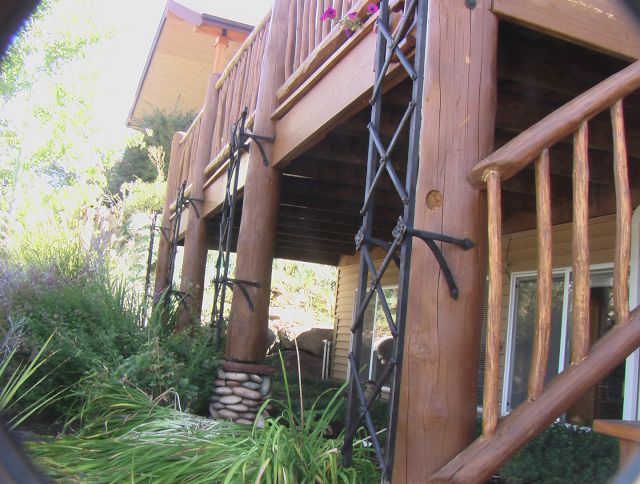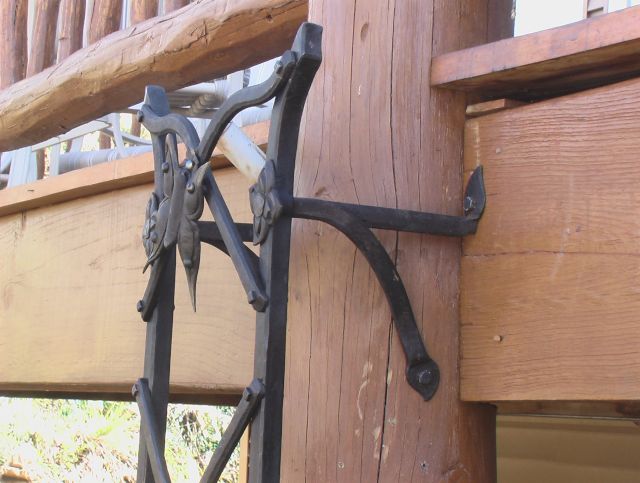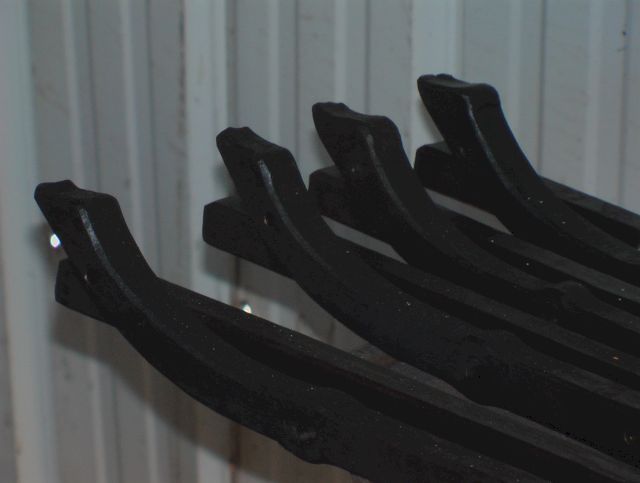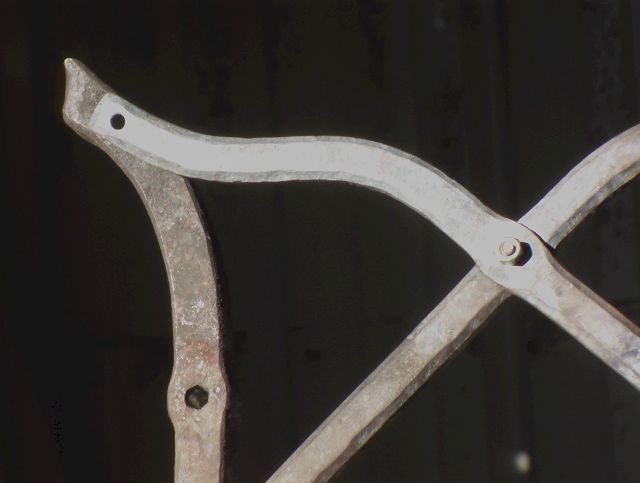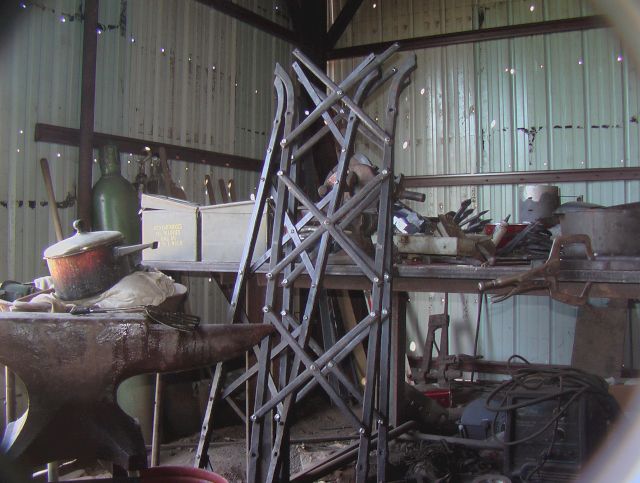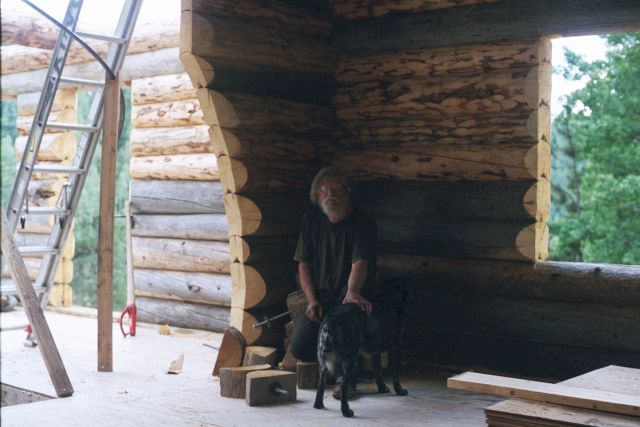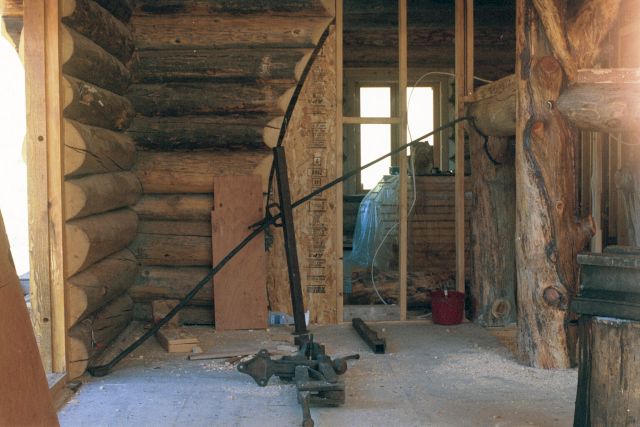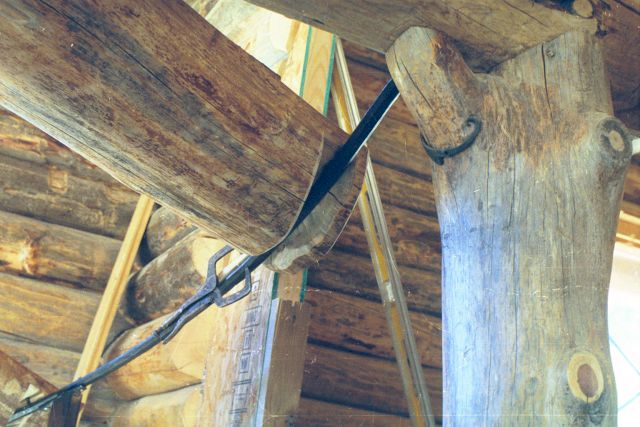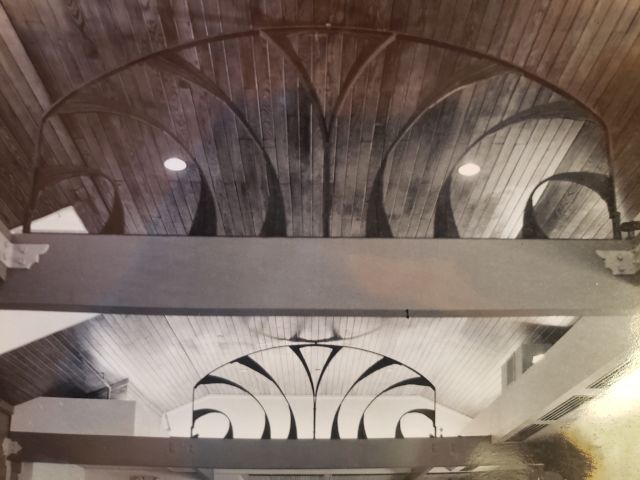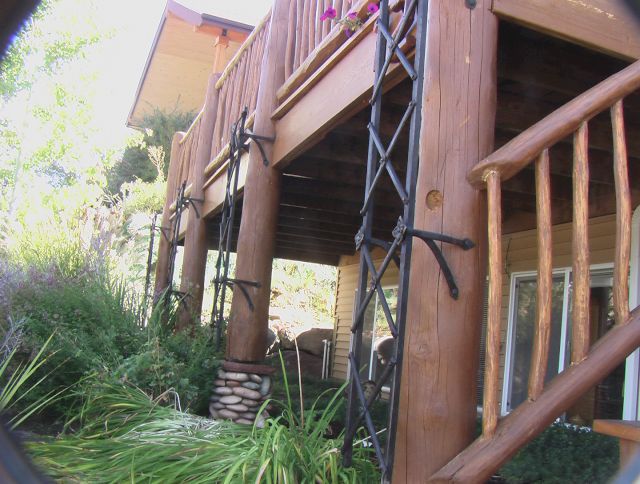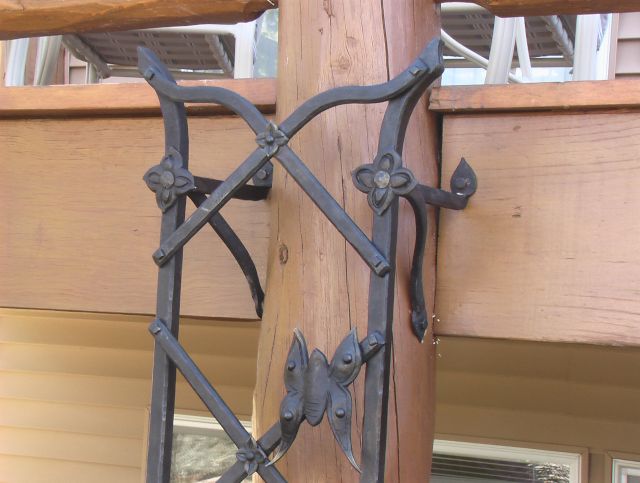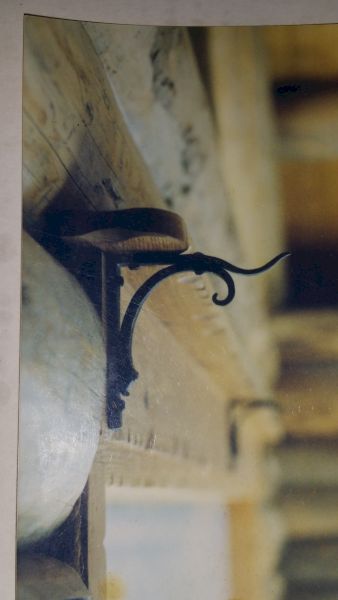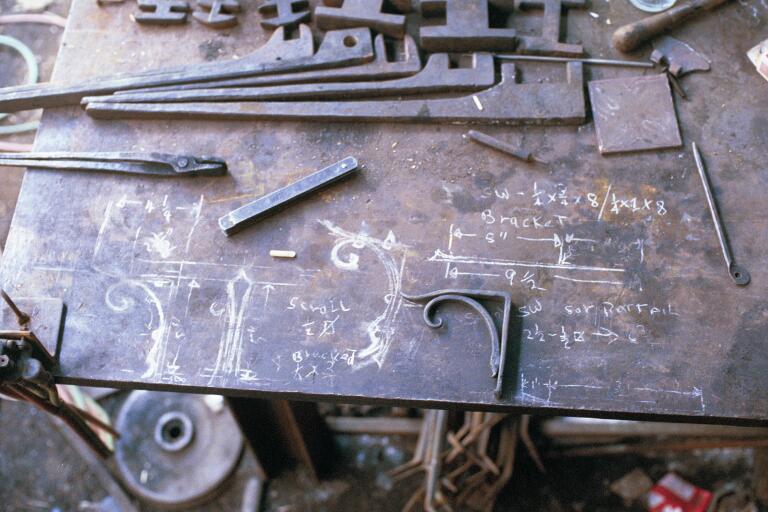-
Posts
3,246 -
Joined
-
Last visited
Content Type
Profiles
Forums
Articles
Gallery
Downloads
Events
Everything posted by anvil
-
Good vid! He calls his tool a slot punch. Usually a punch removes a button or a slug. So, I will assume thats the case. Because of the lost material, the transitions from bar to hole tend to be weak or thin looking. You can see this in the vid. The other way is to use a slit chisel. The difference is that a chisel does not remove any material. This type is called "slit and drift". This way is very precise. You can, in fact lay out all the holes before you make the pass thru's and be very precise. Because you don't lose any material, the transitions are thicker which means stronger. I suggest you buy " The Blacksmiths Cookbook" by Francis Whitaker. He covers this very well and far better than I can. Heres a quick rundown on how its done. I'll do round holes because they are easier to understand. Every hole diameter, no matter what size parent stock, requires a specific length hot chisel. Because a slit chisel is very thin, you get very little upsetting of the hole when the slit is done. Each side of the slit is the same length and is half the circumference in length. When you upset the hole as is shown in the vid, when he is dropping the bar on the anvil not when he is drifting with a drift, You don't get any, or very minimal, change in the material on the sides of the hole. If you use 1" square, the sides should remain 1/2" thick. If you punched your hole, you lose material and the sides will be less than 1/2" thick. Once you finish "upsetting the hole(making it round) it should have the diameter you want and the sides should have the 1/2" thickness. Now you use the drift to just tune up your hole and the sides should not get drawn out. However, the total length of the bar has changed and is now shorter. How much? It depends on the hole size. When you make a test piece, figure how much loss in length you get. If you slit and drift each hole the same way, you will lose the same length for all and the distance between each hole, center to center, will be the same. A little tweak should easily solve any problem, depending on your experience. The cool thing is you can take a 1" square bar, and pass thru it a 1" square bar and the hole sides will be 1/2" thick. In Francis's book, he goes into detail on how he calculates the chisel length and has a nice chart with many lengths figured. Heres some pics. 1" stock, two slit and drifted holes in each 1" bar. All bars were layed out first and center punched. Next the bars were champfered, then the holes were slit and drifted. Upsets on the ends then the bends.
-

Thoughts on guillotine fuller dies for a project
anvil replied to Shainarue's topic in Tools, general discussion
Both work. I prefer spring fuller type tools over guillotine type tools. I hand hold them, not hardy hole type, and figure out how to secure the piece I'm working on. This solves a lot of the bounce and extra blow problem. Usually some variation of a stand and a heavy weight works to hold the work piece. My 25# lil giant really works well here as a modern striker. I can hand hold the tool and the work. My foot controls the hammer. No critique meant. Enjoy tour tool! -

What did you do in the shop today?
anvil replied to Mark Ling's topic in Blacksmithing, General Discussion
Nice! -
Awesome to see you back, Frosty! Hope all is well!
-

Thoughts on guillotine fuller dies for a project
anvil replied to Shainarue's topic in Tools, general discussion
You might know this, but I thought I would add a note of caution. Spring fullers and guillotine type tools tend to jump when struck so they may strike twice and ding your work. -

Gresham's law for management?
anvil replied to rockstar.esq's topic in The Business Side of Blacksmithing
Perhaps better spoken would be Without the ring of the anvil, the work will not even start. Quite frankly, I believe you need to reevaluate your premise. Your premise concerning the crafts appears to be based on the concept that modern craftsmen have evolved from youtube. How sad. When I first read your business posts, I was very excited. Here was an individual involved with the modern construction industry with a great knowledge of business. One of the weak areas within all the crafts is that the modern market is its not favorable to anyone interested in setting up a modern craft business. I was hoping for some insights on dealing with this. Alas, I made an assumption that being here on a blacksmith/craftsman site and involved in construction economics that you would be empathetic to this lack. I rarely make assumptions and shouldn't have done it to you. My bad. Concerning debasement of skill, lets look at just what a "master", "journeyman" and "apprentice" actually are at one particular level. Whats the difference? The master chooses to run a business whilst the journeyman doesn't. The apprentice is the laborer/student. Often the journeyman has a better skillset than the master, he just doesn't want to run a business. With the advent of the industrial revolution, this combination of job availability and education literally ended for the crafts. In the past, a parent could place their child in a craft as an apprentice and his education and economic needs were taken care of. With time he could hit the road as a journeyman and leave his region, be assured of employment and increase his knowledge. Then if he so desired, he could become a master and start his own business. Not so today, even tho one must put in, somehow, your due diligence, spend those 7 years somehow gaining basic knowledge with no guarantee of employment and eventually end up with a successful business. That pathway is possible today for the trades. All things considered, any youth today, can leave home and either go to a jobsite and start out as a rock bottom laborer, or go to a trade school and be guaranteed a job upon completion. From here, the economic/education needs are fulfilled and the end results is open to all who follow this path. As a businessman, you should have no problem understanding this and is why I suggest you reevaluate your premise. The people who are interested in the architectural crafts who knock on your door are those with no education and who have no understanding of the architectural craft market. You have no need for them and they are wasting their time. And those craftsmen who have overcome the myriad of catch-22's know that it is a waste if time to seek you out. I don't know what you do, so I mean no offense. You have mentioned shopping malls, so along with that I include strip malls, tract homes and most office type buildings. Thanks to the industrial revolution there is literally zero need for any of the crafts in this market, just a fact. If this is your market, then i suspect you will never see a qualified craftsman at your door. Thus my suggestion that you check out the local market of fine smiths in the Denver area or up along 285 twards Vail. If you do this, I suspect without a doubt that you will,,, reevaluate your premise concerning the crafts. -

Gresham's law for management?
anvil replied to rockstar.esq's topic in The Business Side of Blacksmithing
I agree with Georges post, especially his last paragraph, even if I question how it applies to the crafts. -
I thought it was a great attempt at humor and right on the mark. Sometimes if you can't laugh at yourself, there is just nothing to laugh at.
-
Lol, I live in the Rocky Mountains, I understand boulders. I built a stone shop once upon a time. I learned that sometimes todays rocks become tomorrows boulders. Must be an age thing. Scott,,, Huh? Rockstar, Thats a hard act to follow. Just remember, we all have our own points of view,,, and crosses to bear. I hope your lifes journada has brought you as much satisfaction as mine has brought me.
-
Well said, George. All things being equal, the skill level of the crafts and trades are equal. Ego has no place here. Having been a farrier for many years, I have no problem being both farrier/tradesman and blacksmith/craftsman. Rockstar, this thread shows me something that we both have in common and that is our views on the stereotype of Boulder and the folks that live there. Its always good to find common ground.
-
Lol, obviously for some reason you seem to be stumbling across Cheap affordable pseudo craftsmanship and in all the right places. I suggest you head up to Carbondale and meet some of the fine iron craftsmen there. Think Francis Whitaker/Tom Joyce quality work,if you know who they are,, and priced accordingly. It beats Laramer Street and Boulder by a long shot. Your above post Sounds pretty hostile to me,,, not to mention that here at IFI, you won't find any of that stuff, nor that quality of junk and babble. You will find a lot of people freely giving of there knowledge to others. I learned decades ago to stay away from Boulder, but hey, whatever floats yer boat. I would suggest that you consider "master your trade" not "craft". They are very different and both are valid and important in the world of construction even when they do the same basic project. Neither is better than the other, unless you get yer knowledge from Boulder,,, Both are dedicated and all things considered have excellent skillsets. There should be no ego bashing between the two. For you to consider a smith to do railings in a new shopping mall is ludicrous, as is having a fabricator do shopping mall type railings in a multi-million dollar home. And yet, those who do your type of work do just that and every time you do, you short your pocket book and massively undersell your client. Tell me thats not a true statement of the state of affairs in todays world of construction, not to mention a poor business practice. I spent my time,, well, I'll change the noun out of respect for the kids,,, mucking thru the "stuff" seeking pearls. And I found them. The muck was the general world of construction, interior decorators, builders, architects, developers, etc, etc, and without a doubt most have your beliefs as to craftsmen and our work. However i didn't quit and found those pearls,, all of the above who were looking for and recognized the value and wants of their clientele. I can't tell you how tiring it gets having people in those positions trying to talk me into doing craftsman work whilst insisting I fit my bid both dollars and time into the mold of a fab shop. Not a one of those "pearls ever attempted to do that. Many had a far better grasp of pricing and encouraged me to price accordingly. From what you post I believe that you have very little real knowledge as to what craftsman and their product actually are considering time and money, much less how and where it actually fits into the grand scheme of things. Heres a hint: A fab shop makes money by how many pounds per hour of iron he moves thru his door. A craftsman's shop makes his money by how many hours he puts into each ounce that goes thru his shop. Just in case you are not aware of it, both business principals have been around for thousands of years. Its amazing how many people want the beauty of a hand forged leaf, but expect to pay the same price as one that is stamped out by the thousands. Tom Bredlow had a great one liner for this. You prolly don't know of him so a little background. He was one of the first presidents of ABANA and one of the founders. He was from Tucson and did fine work in the National Cathedral in D. C. One day a guy came into his shop with a stamped leaf. "Tom, look at this leaf. Its just like yours and costs pennies!" "Just like mine? And for pennies? Guess I might as well make my own." I have no doubt that you are good at your job and my posts on your thread are not a forlorn hope to have you "see the light". My reason is, with all due respect, to encourage those who come here looking for advice on business as craftsmen on what to expect out i the real world and not to become discouraged by "those who follow the road beside the stream".
-
Great vid! Thanks. What it doesn't show is how many years it took him to be able to do those scrolls and, most important, to match them to each other. It is a great example of architectural iron done as a fabricator. Pretty rare. The tools you use are a personal choice and there is no "best" way. It all depends on you. Many come into blacksmithing with a desire to use our traditional and very simple tools,,, forge, anvil, hammer and post vice. Many discover right quick that there is a huge difference between fantasy and reality when it comes down to both learning and using these tools. With experience you can make anything you want in iron with the toolset of a fabricator, a blacksmith, or any combination you choose. My choice is to use the tools and joinery of our craft. I don't cut my tapers with a grinder, nor do I bend my finials cold, but literally every blow he made on the finials and the rest of the scrolling could be a mirror image of me at the same task. I do most of my curves as he did with bending forks and a scrolling wrench. These tools are made as a set and the sets are made to fit different size iron. The bigger the steel, the bigger the tools and the longer the handle(for leverage) will amaze you as to what you can bend hot or cold. Heres some examples. The first three are the bottom stringer on a curved rail. It started out as 1-1/4" square stock forged on the diamond, then bent hot and cold. The finial was forged hot, then cold fitted to the log. On the 3rd pic(i hope) you can see how the stringer attaches to the treads.The next is a truss, 10'x4'. The frame is 1/2"x2" and was bent with forks and wrench cold. I also did the brackets. A forged right angle and hot cut and filed detail. You mentioned a garden trellis. The last 3 are just that. The final is a small bracket. Forged right angle, hot forged finial and all other scrolling done cold over the hardy hole of my anvil. All work is done "by hammer in hand", no grinder, torch, welder etc.
-
What JHCC said. I would guess you are using the wrong lube. Seems that your in house engineers or their equivalent should have an answer. Also, check with the tech service of the company that manufactures your stock for solutions. Not the retail source( they may have an answer), but the actual manufacture.
-
Awesome!
-
A blacksmithing friend once defined Aries as someone standing in the middle of the freeway, separating the wheat from the chaff. I find that fits me better than your stream example. Luck, a new topic to our discussion. Altho I don't remember his name, an elderly and very famous classical pianist/composer was talking with a reporter. The reporter commented on how lucky he was to be in his position. His response, paraphrased, was " Lucky? If luck means practicing 24-7-365, then yes,,, I'm lucky. Timing: Timing is all, combined with the 3 "D's", Desire, Dedication, Determination, creates success. Timing does affect us all, and we all choose how to deal with it. Considering our discussion, the 40-50 year population boom in Colorado has created many opportunities,, some build shopping malls and tract homes whilst others become craftsmen. They are all viable choices and pathways with none being any better or worse, just choices that we make. The timing was right for both of us. Walking on the bank of the stream is an interesting concept. Let me give you a personal example. You being from the greater Denver area, I'm sure you know of the Rampart Range Road. I lived on the rampart for many years. Cross country skiing was my passion. As the area grew, the local cultural rags began to print many articles glorifying the RRR as a beautiful ski trail. They closed the road just above me every year, and there began the trail. Well, I'd gone out my back door to begin my skiing in the National Forest for a couple of decades and it was superb. Virgin powder snow, no people, blue sky's,,, all you could expect. One day I decided to try the trail that was touted in the news. The first thing I saw was a mass of parked cars, nearly 100 people in line trecking on well worn trails, trash scattered along the way and noise... All I could do was shake my head and think,,, different strokes for different folks. I commented on the crowd and one person said you should see it when its really busy. I told him and his partner of the pristine beauty just 50' away and down the hill. The look on their faces was all the needed answer. I turned around and went home and within 30 minutes was headed out my back door and into my own personal beauty that I was so lucky to have as my back door. If you follow the well worn trail, one behind the other, or jump from rock to rock in the stream is just a personal choice. It is not an empirical or boolean equation, its absolutely nothing more than a subjective choice. You know what the really sad note was, concerning that couple? They didn't even know the stream below existed! What I find interesting is the anger from those who are in your profession twards craftsmen in general. Why the anger? I accept without question that in modern construction the need for craftsmen is limited. Trades rule, and appropriately so. I have no clue, but say 80%-90% of construction has no need for craftsmen? But that last %? It cannot exist without craftsmen,,, unless your goal is complete mediocrity. The clients in that segment demand it. And yet, contractor after contractor try to convince their clients that their demands are frivolous. But not all... Not all,,, And the rest provide a great business for those who apply the 3 "D"s and put in the absolutely needed time to master their craft. Anger often comes from a threat. Why is that small % such a threat? That, my friend, is what puzzles me. Lol, Scott, creativity and craftsmanship often do not go hand in hand. Speaking for "we who have little to no creativity", dedication to technique can fool many into believing we are creative. I think my creativity lies in my ability to figure out a pathway to success, not in the creativity of my iron.
-
Interesting insights into your philosophy. Perhaps I have a better understanding into your thoughts on craftsman and their place in your world of high tech contemporary construction. Who defines "foolish"? I believe there are far more who aren't craftsmen that define its pursuit as foolish, than those who are successful as craftsmen.
-

What did you do in the shop today?
anvil replied to Mark Ling's topic in Blacksmithing, General Discussion
I heat treat all of my hot work tools. Yes, you lose the temper on the working edge, but you don't lose the temper above the working edge. This will keep your tool usable far longer. Also, there are two ends to your tool, a working end and a struck end. I always heat treat the struck end, and draw it to a dark blue. This is soft enough to not splinter and it is hard enough to not mushroom with use. Finally and most important, this question is most often asked by those new to our craft, so, it is an opportunity to practice heat treating and the more practice,,,,,,, is money in the bank of knowledge. -

dDetermine depth
anvil replied to Caballo bueno's topic in Solid Fuels: Coal, Coke, Charcoal, Wood, etc
could be a bottom blast forge as well. Lol, that about covers the options,,, -

What did you do in the shop today?
anvil replied to Mark Ling's topic in Blacksmithing, General Discussion
Nice work, you guys. Inspirational. -

dDetermine depth
anvil replied to Caballo bueno's topic in Solid Fuels: Coal, Coke, Charcoal, Wood, etc
This may be a language problem, not sure. What do you mean by blast forge? Got a picture? -
You might be at the wrong site, well, not wrong site, but This is a blacksmithing site. We forge iron and stuff like that. We may have a bit of knowledge and advice for you, but you will prolly get better info for your project if you go to a casting site, and most likely there is a bronze casting site if you look.

